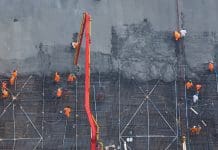Construction PMI data for June revealed a sharp turnaround in the performance of the UK construction industry, as the phased restart of work helps lift output volumes
June construction PMI data pointed to a sharp turnaround in the performance of the UK construction sector thanks to the phased restart of work on site.
New orders also stabilised after three months of severe declines and purchasing activity expanded at the fastest rate since December 2015.
The seasonally adjusted IHS Markit/CIPS UK Construction Total Activity Index jumped to 55.3 in June, from 28.9 in May, to signal a strong increase in total construction output.
The latest construction PMI data signalled the steepest pace of expansion since July 2018. Higher levels of business activity were linked to the reopening of the UK construction supply chain following stoppages and business closures during the early stages of the Covid-19 pandemic.
Construction activity performance
Residential building was the best-performing area of construction activity in June. Around 46% of survey respondents noted an increase in housing activity, while only 27% experienced a reduction. The latest expansion of residential construction work was the steepest for just under five years.
Commercial work and civil engineering activity also returned to growth in June, although the rates of expansion were softer than seen for housebuilding.
New business volumes increased marginally in June, which ended a three-month period of decline.
However, the rate of new order growth was far weaker than seen for business activity, reflecting hesitancy among clients and longer lead-times to secure new contracts.
A number of construction firms noted that new work related to infrastructure projects was a key source of growth in June.
According to the latest construction PMI data, employment numbers fell at the end of the second quarter. Reports from panel members suggested that worries about the longer-term demand outlook had led to cautious hiring policies and, in some cases, redundancies alongside furlough arrangements in June.
The index measuring business expectations for the year ahead remained historically subdued, but climbed to its highest since February amid a boost from the reopening of work on site. Exactly 46% of the survey panel anticipate a rise in business activity, while 31% forecast a reduction. The latter mostly commented on concerns about the wider UK economic outlook.
Severe supply chain disruptions continued in June, reflecting stronger demand for construction inputs and ongoing reports of constrained materials availability (particularly plaster). This resulted in another rise in purchasing costs, with the rate of inflation accelerating to its highest since the start of 2020.
‘Stars of the UK economy’
Duncan Brock, group director at the Chartered Institute of Procurement & Supply, said: “Builders were the stars of the UK economy in June with the fastest rise in purchasing activity in almost five years, as pent-up building plans were unleashed following the easing of lockdown measures.
“Housing led the way with the other main sectors closely behind as several larger infrastructure projects were also on the move.
“As business confidence improved to its largest extent since February, companies were buying up materials and laying the groundwork for a stronger summer’s end. This resulted in the highest input price inflation since the start of the year as supply chains creaked under the strain of increased shortages.
“Building performance is dependent on other sectors recovering at a similar pace, and as businesses were opening up, some fell short of their usual delivery capacity.
“Only two months ago the construction sector produced the worst results in the history of the PMI, and there are still some potholes to navigate around as Government support for jobs is stripped away.
“Employment levels remained deflated, with reports of redundancies, furloughed staff and a reluctance to boost staff numbers when new order levels remained so flat. But with a significant rise in the headline output number, it looks as though all the building blocks are there for the sector’s increasing health…”














